DRAFT: Open letter to NASA | Response to final PEIS | Fails NEPA requirements | Main points in open letter in more depth | Finding an inspiring future | Executive summary of preprint | Low risk like house fires and smoke detectors | About me | DRAFT: Endorsements by experts | Why this needs an open letter with endorsements | Call to NASA to defer or withdraw EIS | Letters | BOOK: Preprint to submit to academic publishers
Author: Robert Walker, contact email robert@robertinventor.com
NASA for all their excellence in space missions are not experts on biosafety
- as their main argument for their plan to protect Earth from samples from Mars
- they say any life on Mars can get here better protected and faster in a Mars meteorite
- than in a sample tube
- their main cite for this rebuts their own argument.
- looking for a Carl Sagan who will help them get back on track
- who cares deeply about protecting Earth's biosphere and inhabitants
- from likely low risk but of large scale harm to human health and environment
-
much as they care about their own house
-
that it is safe from the low risk of a house fire
I hope you can take a little time to check out what's happening with the NASA Mars Sample Return Environmental Impact Statement, their plans for how to protect Earth's inhabitants and biosphere. But that's hardly NASA's competence. You wouldn't go to NASA to handle an Ebola outbreak. The trouble is they closed down their planetary protection office and interagency panel who would have told them how to do it.
NASA can finalize their PEIS any time after June 26th (NEPA, 2023, NEPA; Mars Sample Return Campaign) I don't know if they have yet.
I feel it's essential for NASA to maintain integrity, credibility, and to comply with NEPA requirements, and I am sure you will too if you are like Carl Sagan. He cared deeply about scientific integrity and also cared deeply about biosafety, Earth's biosphere and its inhabitants.
Click here to show video in YouTube: NASA needs to withdraw its plans to contain Mars samples - main argument rebutted by its own cite
All the experts are of the view that the risk is likely low. They agree that this very low risk includes a risk of large scale harm to human health and to the environment. But the risk of a house fire is low and we take precautions to prevent house fires and regard it of high importance to make sure houses are built properly and the smoke detectors work and so on.

Hand installing smoke detector labeled “NASA” and wooden ceiling of a house labeled“Earth”
I am doing all this to get NASA to install a smoke detector but one that I think is exceptionally important despite the low risk, because Earth’s biosphere is a “house” with billions of people in it.
The European Space Foundation in 2012 said the samples should be contained as if they were risk group 4 (high risk of individual and community spread) until they are better understood
While, based on assumptions, some aspects of the release of unsterilised Mars material can be framed in some way, with such a level of uncertainty, unknown (and therefore unexpected) consequences driven by unknown mechanisms are conceivable and by definition are hardly manageable and predictable.
In this context, confinement of the sample appears to be the best prevention method. This principle is also applied when an unknown pathogen with a high case fatality rate is isolated: it is assimilated to Risk Group 4 and contained in laboratories with the highest level of confinement until further knowledge about the pathogen allows it to be down graded to a lower risk group.
Following the same principle, a priori assignment of a Mars sample to Risk Group 4 appears to be the best measure.
.(Amman et al., 2012, Mars Sample Return backward contamination–Strategic advice and requirements : 24)
NASA's second planetary protection officer Cassie Conley similarly said
“that means we are going to contain the samples as if they were the most hazardous Earth organisms that we know about, Ebola virus.”
at 1:02 into this official NASA video
On environmental effects, the ESF report concurred with earlier reports that the risk appears to be low but is not demonstrably zero.
The Study Group also concurs with another conclusion from the NRC reports (1997, 2009) that the potential for large-scale effects on the Earth’s biosphere by a returned Mars life form appears to be low, but is not demonstrably zero.
(Mars Sample Return backward contamination–Strategic advice and requirements : 20)
A low risk of large-scale effects is highly significant as we see from the example of a house fire.
For more about how this is about a likely very low risk but a very low risk of high consequence for the worst case scenarios, like house fires and smoke detectors see:
My background is I was just finishing what was going to be my first paper on astrobiology, on planetary protection for NASA's very mission at the time that the Environmental Impact Statement process started. See my brief bio: About me. I commented on both rounds of public comments raising these issues which they have done nothing about. This means I have legal standing under NEPA and NASA are legally required to respond to the comments I made, but they haven't done anything many major issues.
NASA still use the MARS meteorite argument in the final PEIS
- and don't mention that it is rebutted
- by BOTH its National Academy of Sciences cites
The final PEIS still uses the Mars meteorite argument, not based on any new science but based on misrepresenting the cites they use. Even when alerted by public comments that the cites rebut the argument, they don't alert the reader to this.
NASA say that any life they return gets here better protected and faster in the meteorites that get to Earth from Mars after large impacts on Mars.
NASA:
The natural delivery of Mars materials [i.e. martian meteorites that reach Earth ] can provide better protection and faster transit than the current MSR mission concept
First, potential Mars microbes would be expected to survive ejection forces and pressure (National Academies of Sciences, Engineering, and Medicine and the European Science Foundation 2019) [CITE REBUTS SENTENCE], …”
(NASA, 2023, Mars Sample Return FINAL EIS 3–3),
[my comment in red in square brackets, and emphasis on central point in red]
The samples they return are sealed in a sample tube with a small amount of Martian atmosphere at Martian atmospheric pressure, like a miniature spaceship for a microbe. The meteorites are ejected into space from big impacts into the surface..
NASA say in this passage that any life on Mars gets here faster and better protected in those meteorites than in their sample tubes.
Without this argument most of NASA's other arguments in the EIS fall apart.
Yet it is directly rebutted by both of the National Academy of Sciences cites that NASA's team thinks they have used to establish it as a scientific consensus.
This argument is even rebutted more briefly already on pages 4-5 of their main National Academy of Sciences cite for it. We can only assume that nobody in their team read the study carefully as far as page 5 of what is arguably by far the most important cite for planetary protection in the EIS.
National Academy of Sciences, 2019 (NASA's cite)
The reasoning regarding natural flux does NOT apply directly to samples returned from the Mars surface. The material will be gently sampled and returned directly to Earth.
The sample may well come from an environment that mechanically cannot become a Mars meteorite. The microbes may NOT be able to survive impact ejection and transport through space.”
...
Finding: The committee finds that the content of this report and, specifically, the recommendations in it do NOT apply to future sample return missions from Mars itself.
(SSB, 2019, Planetary protection classification of sample return missions from the Martian moons : 45)
See:
NASA continue to use three other invalid arguments
- all first used in print in a non peer reviewed op ed by a Mars colonization enthusiast
- immediately rebutted in the next edition of the planetary report
- and give no cites to any peer reviewed paper that comes to the same conclusions
NASA use this argument as well as the other four invalid arguments Robert Zubrin used in a non peer reviewed 2000 op ed. (though they don't cite him) to argue to a conclusion that environmental impacts would not be significant.
Frst presented here (AFAIK): (Zubrin, 2000, Contamination From Mars: No Threat). Planetary protection experts argued vigorously against Robert Zubrin in the next edition of the Planetary Report (Rummel et al., 2000, Opinion: No Threat? No Way : 4 - 7).
These are the other three arguments, in all three cases they fail scientific integrity as you can see:
They confirmed to me in a comment that their reasoning to this conclusion is based on the arguments in their own EIS and that their own EIS is not peer reviewed (as is obvious from reading it).
NEPA doesn't require EIS's to be peer reviewed but it does require scientific integrity.
NONE of these arguments are based on any new science and NONE of them are cited to any peer reviewed paper that uses the same argument.
Based on a conclusion that environmental impacts would not be significant, NASA restricts the "affected location" to Utah Test and Training Range instead of Global
Based on that conclusion that the environmental effects would not be significant they then conclude that they can restrict the "affected location" for Environmental effects to the Utah Test and Training Range instead of setting it to Global as one would expect.
I.e. the scope of their EIS which they set at the outset of the process is based on the non peer reviewed arguments within the EIS, and the most important is the Mars meteorite argument.
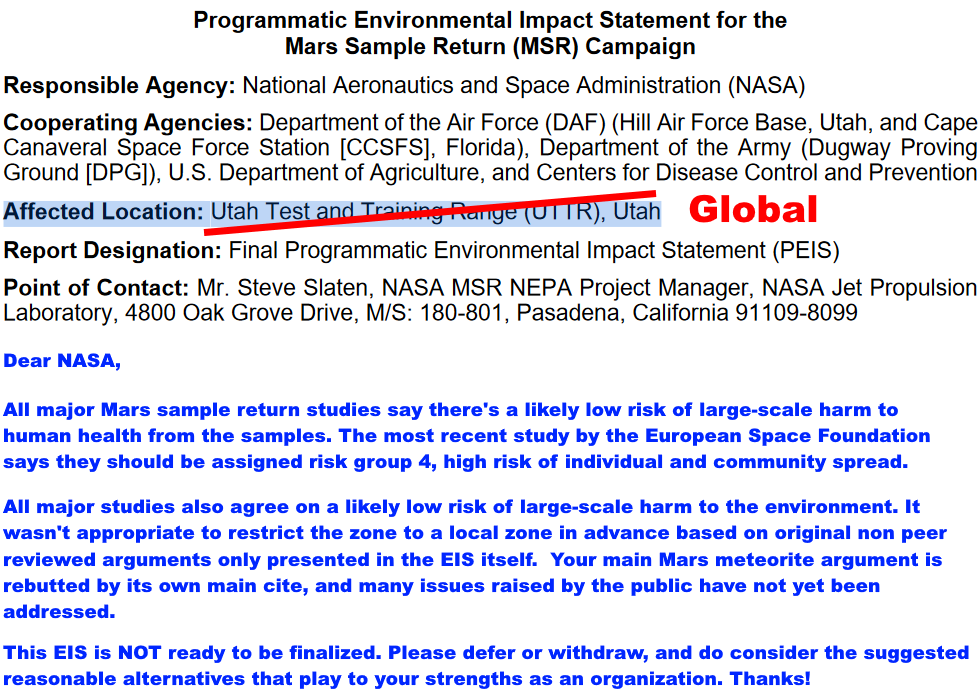
Text on graphic:
Affected location:
Utah Test and Training Range (UTTR), UtahGlobalDear NASA,
All major Mars sample return studies say there's a likely low risk of large-scale harm to human health from the samples. The most recent study by the European Space Foundation says they should be assigned risk group 4, high risk of individual and community spread.
All major studies also agree on a likely low risk of large-scale harm to the environment. It wasn't appropriate to restrict the zone to a local zone in advance based on original non peer reviewed arguments only presented in the EIS itself. Your main Mars meteorite argument is rebutted by its own main cite, and many issues raised by the public have not yet been addressed.
This EIS is NOT ready to be finalized. Please defer or withdraw, and do consider the suggested reasonable alternatives that play to your strengths as an organization. Thanks!
I expect many of you will agree that with this background it was not appropriate to restrict the Affected Location in advance to the Utah Test and Training Range (UTTR), based on non peer reviewed reasons first given in the EIS itself.
You can endorse that the "Affected location" should have been set to global from the start here on the endorsements page.
We do have to take care of a small risk of large scale harm just as we do for a house fire
My view is like Carl Sagan. The risk is likely low but the worst case scenario is catastrophic like a house fire. For instance it's not impossible we return mirror life, in some scenarios or a novel fungal genus like Aspergillus fumigatus but one that our immune system has never seen before.
This for instance is about the mirror life scenario as an example of exotic biology. It's the one form of life there's a reasonable consensus about that it would work, life that's evolved from the mirror organics from the organics terrestrial life uses. .Although it would be independently evolved we can show that it is feasible because terrestrial life with all the chemicals flipped as in a mirror should still function. We can be pretty sure there ARE mirror life planets out there unless we are the only planet with life in the universe. Perhpas the nearest mirror life planet is thousands of light years away. But we simply have no idea how easy it is for life to evolve.
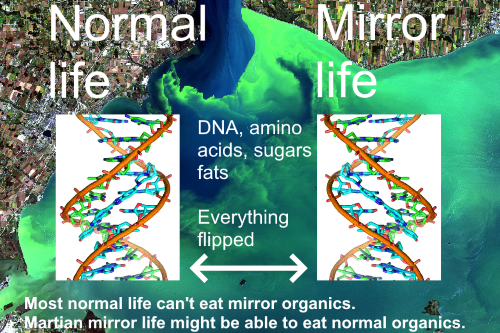
Text on graphic: Normal life, Mirror life, DNA, amino acids, sugars, fats, everything flipped. Most normal life can’t eat mirror organics. Martian mirror life might be able to eat normal organics.
NASA has made many extraordinary geological discoveries on Mars, such as the CO2 geysers.

Text on graphic: Artist’s impression of CO2 geysers on Mars, one of many geological surprises.
Mars could have astrobiological surprises too.
Like mirror life, or like an alien fungus.
Or just a terrestrial fungus, related life but a new genus that terrestrial life has never seen before.
Aspergillus fumigatus is not adapted to an infectious lifestyle in any organism has characteristics many of which would be likely shared by Mars organisms, attacks us mainly by using chemical barriers and chemicals to attack our lungs to digest the organics. Although not adapted to us at all, 200,000 people immunocompromised people get a serious disease with fatality rate 30% to 95% and then there's the opposite problem with 400,000 a year with a chronic progessive allergic lung disease.
Even an alien fungal analogue could do that. I developed those two scenarios to try to encourage space agencies to take more care to protect Earth.
I see it as like taking precautions against a house fire, likely at a similar level of risk but for a house with billions of people.
NASA should protect Earth even against ultra-small bacteria which may well be found on Mars as they do well with low levels of nutrients
- harmless on Earth but we don't know in advance that ultramicrobacteria with novel properties or of a new biology from Mars will be harmless
Click here to show video in YouTube: NASA needs to withdraw its plans to contain Mars samples - main argument rebutted by its own cite (2)
For insance, NASA should consider the minimum possible ultra-small bacteria in their plans to protect Earth's biosphere.
This is a size limit in a recommendation for containment set by the European Space Foundation (ESF) which as far as I can tell in my literature search so far can't be achieved by any current or proposed air filter technology.
- ESF recommendation:
"The release of a single unsterilized particle larger than 0.05 μm is not acceptable under any circumstances"
(Ammann et al., 2012, Mars Sample Return backward contamination–Strategic advice and requirements : 48).
- HEPA filters:
certified for a 4000-fold reduction in particles at 0.3 microns (99.975 containment).
(WHO, 2003, Laboratory Biosafety Manual Second Edition (Revised) : 35)
So HEPA filters can't comply with the ESF recommendation.
This new size limit was the result of new science which revealed that some microbes, the ultramicrobacteria, can be long and thin, and remain still viable after passing through 0.1 micron nanopores. This makes them far smaller than was realized to be possible when the previous limit of 0.2 microns was set in 1999 (Ammann et al., 2012, Mars Sample Return backward contamination–Strategic advice and requirements : 15).
The European Space Foundation cited two studies that established this, in freshwater from Greenland (Detection and isolation of ultrasmall microorganisms from a 120,000-year-old Greenland glacier ice core) and 20 different sites in Switzerland (Quantification of the filterability of freshwater bacteria through 0.45, 0.22, and 0.1 μm pore size filters and shape-dependent enrichment of filterable bacterial communities).
This result about the viability of ultramicrobacteria after passing through 0.1 micron nanopores has been confirmed many times since then and the ultramicrobacteria that got through have also been imaged using electronomicroscopes (they are far too small to be seen with optical microscopes even at the highest optical resolution possible of 0.2 microns).
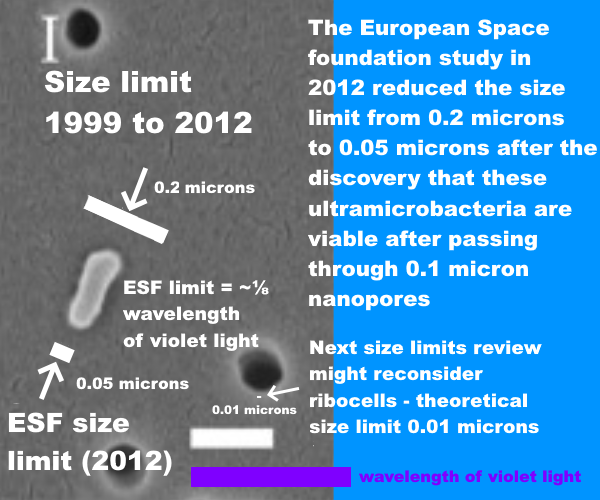
Text on graphic: Size limit 1999 to 2012: 0.2 microns
ESF Size limit (2012): 0.05 microns
The European Space Foundation study in 2012 reduced the limit from 0.2 microns to 0.05 microns after the discovery that these ultramicrobacteria are viable after passing through 0.1 micron nanopores
Next size limits review might reconsider ribocells – theoretical size limit 0.01 microns
ESF limit = ~⅛ of the wavelength of violet light
Background graphic: SEM of a bacterium that passed through a 100 nm filter (0.1 microns), larger white bar is 200 nm in length (Passage and community changes of filterable bacteria during microfiltration of a surface water supply)
violet bar for shortest wavelength of violet light (380 nm or 0.38 microns)
Mars might well have tiny microbes because
- very small cells can escape grazing by larger grazing amoebas which don’t notice them
- very small cells have a larger surface area to volume ratio, so can use nutrients better in nutrient poor conditions
See: (Ghuneim et al., 2018, (Nano-sized and filterable bacteria and archaea: biodiversity and function)
NASA never mention this requirement saying
-
they don't concur with me when I said that this is beyond the ability of a HEPA filter
- you shouldn't deal with a serious issue raised by the public
-
by just saying you don't concur with it without getting anyone expert to lpok at it!
- and from how they work the HEPA technology itself can't attain 100%
- because a small number of particles below the mesh size always go through
NASA told me in their reply to my comment in the final PEIS, that they didn't mention this requirement because they don't concur with my assessment that a HEPA filter is unable to comply with the ESF recommendation.
I.e. NASA plan to use HEPA filters to contain 100% of all particles of 0.05 microns upwards and they don't see it as necessary to mention this to the public because they think HEPA filters do this already.
The HEPA technology is based on a maximum penetrating size of particle. It's not possible using the technology to contain 100% of particles smaller than the largest gap between the fibres.
So, I hope you will agree it wasn't an adequate response by NASA to deal with that issue by just replying to a comment in their final PEIS saying that they don't concur that it is an issue.
Here is that reply to my comment, what I said to NASA and their comment reply in the final PEIS:
Robert Walker
Draft PEIS OMITS the 2012 European Space Foundation study which reduced the size limit to 0.05 microns from the previous value of 0.2 microns – a serious omission since containment at 0.05 microns is well beyond the capability of BSL-4 facilities
...
ESF study: “the release of a particle larger than 0.05 μm in diameter is not acceptable in any circumstances”(NASA, 2023, MSR FINAL EIS 3–3),
I.e. the ESF requires 100% CONTAINMENT AT ALL SIZES FROM 0.05 MICRONS UPWARDS.
NASA's reply is they don't concur with me that a BSL-4 using HEPA filters can't achieve containment at 0.05 microns.
NASA
NASA is aware of the ESF Mars Sample Return backward contamination study. NASA does not concur that 0.05-micron (50 nm) particles cannot be managed; standard High Efficiency Particulate Air (HEPA) filters like those used in biosafety facilities are tested for effectiveness at or near the Most Penetrating Particle Size (MPPS), which is typically 0.12 micron .... (Perry et al, 2016, ( Submicron and nanoparticulate matter removal by HEPA- rated media filters and packed beds of granular materials). “Particles both larger and smaller than the MPPS (including bacterial spores and viruses) are removed with greater efficiency.”
(NASA, 2023, MSR FINAL EIS : B-62)
Their reasoning is hard to follow. But I have come across this mistake before in understanding of the ESF requirement. HEPA filters do block out nearly all of 0.05 micron particles (not 100% but so close it looks like 100% on a graph). That's for round particles, elongated ones and ones that clump may not behave the same way.
I think they may have missed the "greater than" in the text I quoted from the ESF study. Of course that makes no sense in terms of public health, even if the aim was only to contain ultramicrobacteria they can be attached to larger dust grains or clumped together.
But an engineer might read it that way.
I go into details here
This is one of numerous very major mistakes.
I hope you can agree this is not ready to be finalized
I hope you can find some time to look this over and if you agree, do you have any other thoughts on what to do.
There is nobody on the team able to enter into a dialog on planetary protection, if they can't read their own cites to see that they rebut the Mars meteorite argument and can't follow reasoning about small particles based on the published specifications of HEPA filters, there is nobody there who is able to respond.
So my hope is to take this to a wider audience. First priority is to get them to defer the EIS as it is clearly not ready to be finalized.
If you agree I hope you'll consider signing this call to NASA to defer or withdraw this EIS.
Call to NASA by experts in relevant disciplines
- to defer finalizing your Environmental Impact Statement for a Mars Sample Return mission
- or to withdraw your EIS
- because it hasn't addressed many serious issues raised by the public
- and lacks scientific integrity
- for instance the Mars Meteorite argument
- its most important planetary protection sentence, is
- rebutted on page 5 of its main cite to the National Academy of Sciences
- and the "Affected area" for environmental effects is
- restricted to the Utah Test and Training Range
- from the start of the process
- based on non peer reviewed arguments found only in the EIS
- instead of set to "Global" as in
- all previous Mars Sample Return Studies
Also if you feel it's appropriate, to endorse anything in this endorsements page:
No NEPA lawyer but this isn't subtle - very very clear violations of many central NEPA requirements
I'm no NEPA lawyer, not a lawyer at all but it isn't about subtle issues. Very very clear violations of many central requirements under NEPA.
This EIS would just fall apart if anyone took NASA to the courts unless NASA could somehow block any actions. But I very much don't want to do that. Of course couldn't do it myself but e.g can imagine the Audubon society as an example often take up NEPA cases and they would win this one if it went to the courts for sure.
I don't think NASA can have consulted a NEPA lawyer or they ignored what they said.
If NASA understood their legal obligations they would engage with the public
- and by the conclusions of the Mars Sample Return Studies this is essential to the success of the project also
- as well as legally required for NEPA
I've got legal status as someone who commented on their mission plan in a timely fashion under NEPA so they are legally required to respond to any significant issues I raised and to consider the reasonable alternative I suggested and they aren't complying with that requirement.
So if they understood NEPA law they would realize they do have to act. But I think I'm talking to engineers, scientists and mission planners who have little interest in law either. They are just going to keep going blindly with the aim to get back to their engineering and go on with the mission plan as soon as possible.
But this is not going to work long term. As I'm sure you'll know, ALL the major Mars sample return studies stressed the importance of engaging with the public and listening to their concerns and responding to them meaningfully. As John Rummel put it, NASA's first planetary protection officer:
“Broad acceptance at both lay public and scientific levels is essential to the overall success of this research effort.”
(Rummel et al., 2002, A draft test protocol for detecting possible biohazards in Martian samples returned to Earth : 99)
I think one way to put it that an engineer might understand, is that this broad acceptance is as essential for this mission as ensuring that they have enough rocket fuel to get their samples back to Earth.
But they haven't set up any way to engage with the public and there is no dialog going on here.
So - it's clear there is nobody there I can talk to, on NASA's team and I can't resolve this by talking to them (they didn't reply to my email and anyway I now know from their replies to public comments and the EIS itself that there is nobody left on their team who knows enough about planetary protection to have a meaningful conversation with me on the topic).
A systemic issue since Apollo
This is a systemic issue, NASA did the same for Apollo. That was before NEPA and they set up their internal interagency panel so they could override any decisions any of the other agencies made (Meltzer, 2012, When Biospheres Collide : 193).
- In the Apollo era NASA had an interagency panel
- but all discussions were private and it was set up so no changes could be made to NASA's plans without NASA's own approval
- NASA used those powers to tell the astronauts to open the Apollo 11 door while still floating in the sea
- against the objections of the National Academy of Sciences whose representative Vishniac said it would make the rest of the quarantine program pointless
So the open letter is the only solution I have
- to ask for endorsements and go to a wider audience
- not to stop the mission but find a way for NASA to do it safely
So the only solution I can think of is to do an open letter, and ask for endorsements and to take this to a wider audience. My aim isn't to stop NASA's mission, I'm a long term admirer of NASA and very interested in both humans in space and astrobiology myself. My reasonable alternative, which I submitted under NEPA plays to NASA's strengths.
Carl Sagan is one of my heroes and I have the same focus as him in this respect. Enthusiastic about space science. Keen on space exploration, including both robotic and human exploration. Watched the Apollo landings in amazement in the 1960s. Marveled at the Voyager “grand tour” of the solar system. But I also greatly value Earth’s biosphere and its inhabitants.
I myself am very keen on human exploration in space and eventually likely settlement (though I think it's likely harder and may take longer than many space colonization enthusiasts expect)
But like Carl Sagan I also value Earth's biosphere and inhabitants hugely, value essentially infinite.
Right now am trying to find someone, a Carl Sagan, someone who cares like Carl Sagan when he said:
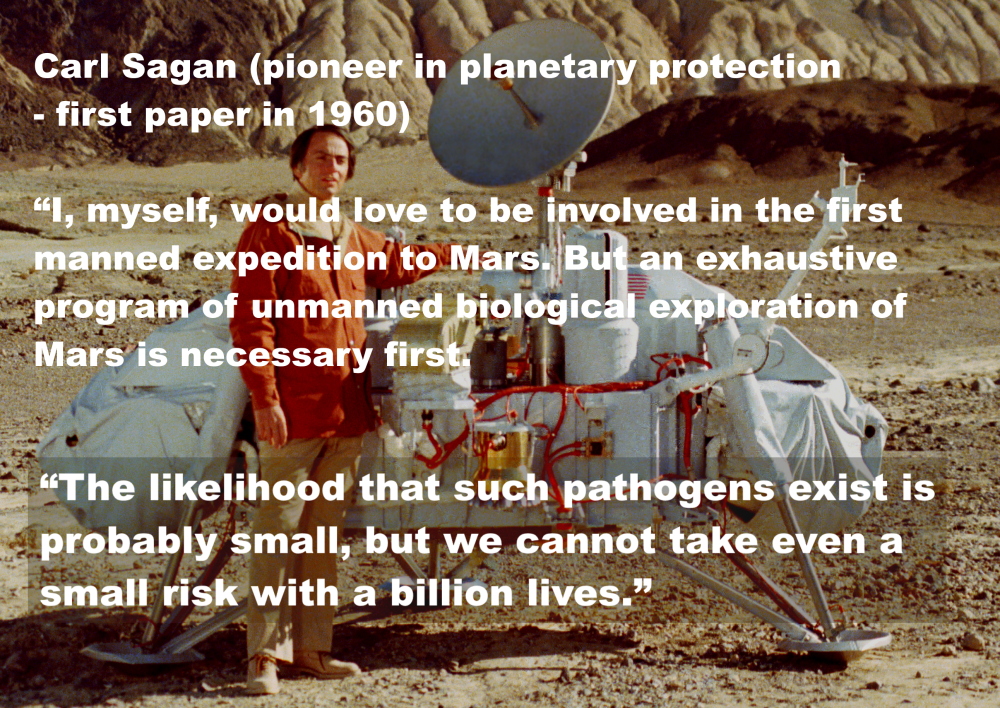
Text on graphic: Carl Sagan (pioneer in planetary protection - first paper in 1960)
[his first paper is (Biological contamination of the Moon)]“I, myself, would love to be involved in the first manned expedition to Mars. But an exhaustive program of unmanned biological exploration of Mars is necessary first.
“The likelihood that such pathogens exist is probably small, but we cannot take even a small risk with a billion lives.”
[quote from: (Sagan, 1973, The Cosmic Connection – an Extraterrestrial Perspective]
[I provide text captions for the graphics in this open latter for visually impaired readers]
I am sure Carl Sagan would be doing what I'm doing right now. I wish he were still alive. NASA wouldn't have been able to do this with Carl Sagan still around. If I find someone like that with a viable path forward too, and the enthusiasm to deal with it that's the best solution.
Some of you may be sympathetic to this, but due to connections with NASA or other reasons wouldn't want to get involved yourselves.
If so - you could help by suggesting someone else to contact.
From their history NASA aren't an organization that one can expect to be able to oversee a biosafety plan or a biosafety laboratory
- just as the CDC couldn't oversee a mission to Mars
Even with a wider audience and understanding of this issue, from this EIS and from their recent history, I don't think NASA can hope to produce a competent biosafety plan based on containing the materials in their own facilities even if it was possible.
That would be like asking the CDC to oversee a mission to Mars from mission control without any help from NASA employees.
Meanwhile from the recent history, such as closing down and not listening to the interagency panel, NASA clearly can't be expected to work well with the CDC or NIH in day to day running of a biosafety laboratory or design decisions about how it needs to be constructed to contain the samples.
If NASA ever seriously consider lab leaks
- there is no acceptable quarantine period keeps out fungi, mirror life or diseases with long latency periods or symptomless spreaders
- so no solution for samples from Mars in a lab run by humans
- we have to go fully telerobotic to solve this
So far, NASA haven't considered lab leaks or quarantine, postponing it to Tier 2, but if they ever do give it serious thought, they will encounter the same very difficult issues the Apollo team did.
There seems no solution to the issue of quarantine for lab leaks of a laboratory run by human technicians. This is an issue raised early on by Carl Sagan who talked about the "vexing question of the latency period" for Leprosy.
There is also the vexing question of the latency period. If we expose terrestrial organisms to Martian pathogens, how long must we wait before we can be convinced that the pathogen-host relationship is understood? For example, the latency period for leprosy is more than a decade.
(The Cosmic Connection – an Extraterrestrial Perspective : 130)
We now know that leprosy can take 20 years or more to show symptoms (WHO, 2019, Leprosy, Key facts,)
We can add many things to that. Carl Sagan could equally have used lifelong symptomless spreaders like Typhoid Mary, and there is no way to keep out mirror life or fungal diseases with quarantine.

Text on graphic: Mold growing on a Zinnia plant in the ISS. The mold fusarium oxysporum likely got to the ISS in the microbiome of an astronaut (Draft genome sequences of two Fusarium oxysporum isolates cultured from infected Zinnia hybrida plants grown on the international space station). (How Mold on Space Station Flowers is Helping Get Us to Mars)
The Apollo program used quarantine, but this was a decision made by NASA, who are not expert in epidemiology
So - it seems the only way to go with a ground based facility would be a fully telerobotic laboratory but that would be expensive (likely well over half a billion dollars) and also not within NASA's field of competence.
So that leads to my reasonable alternative
- a miniature life detection lab above GEO based on NASA. and ESA's joint plan to search for life in situ on Europa
- humans go nowhere near and everything returned to Earth is sterilized
- so it's 100% safe for Earth (no appreciable risk)
So that leads to my reasonable alternative. Based on NASA and ESA's joint plan to search for life in situ on Europa from 2016.
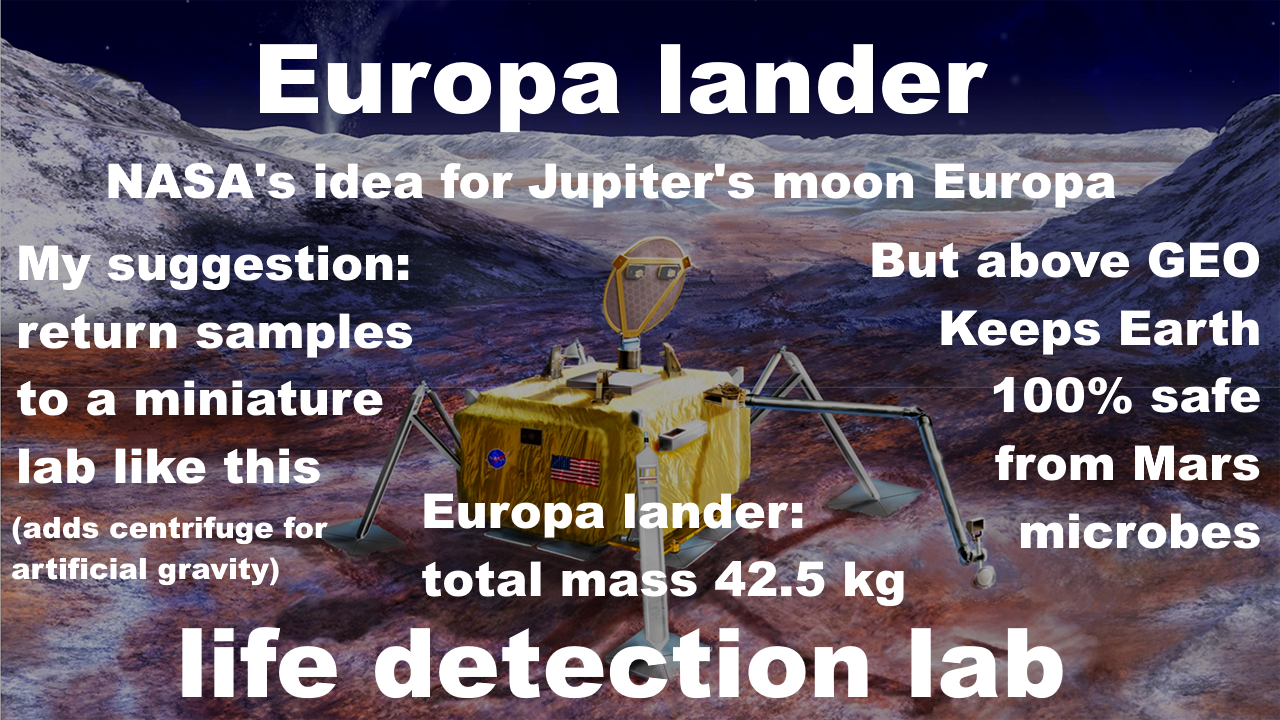 .
.
Graphic from (NASA, 2017, Europa Lander Study 2016 Report)
It would be returned to above GEO in a safe inclined orbit in the Laplace plane so it can't contaminate satellites in GEO
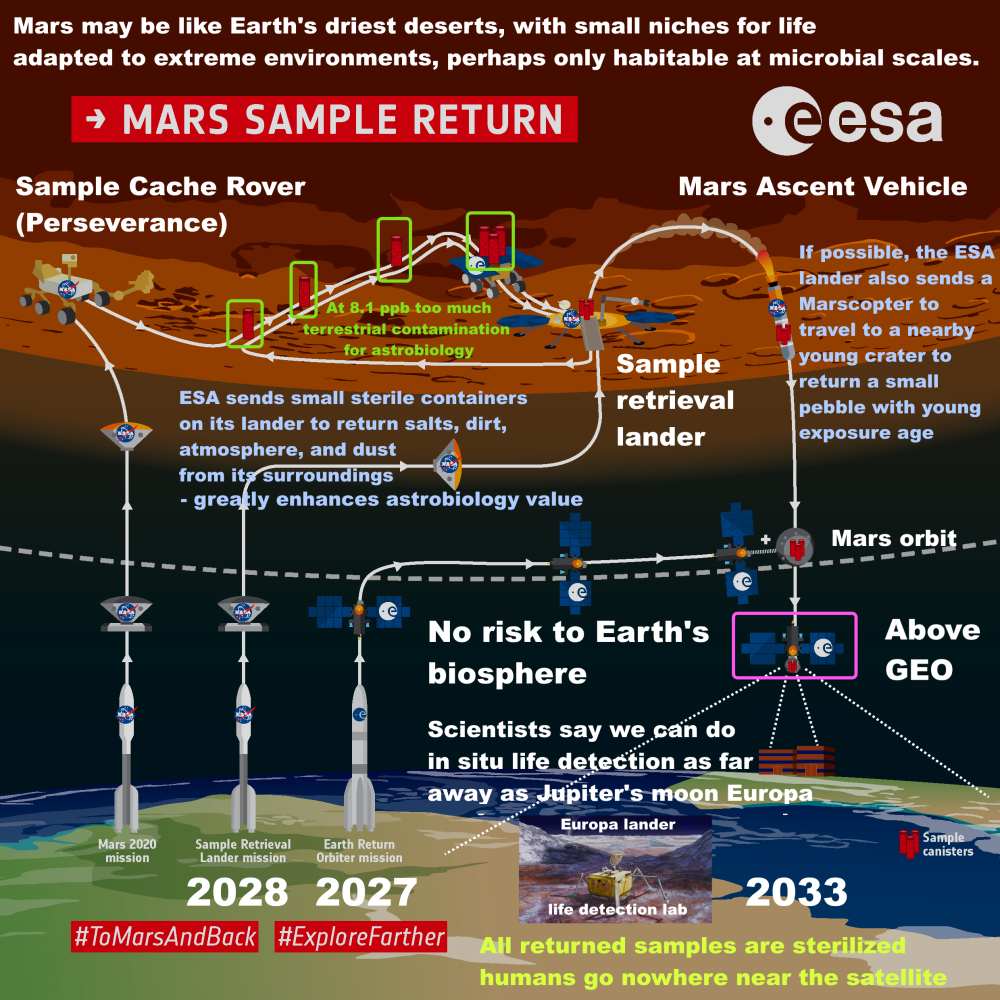
Graphic obtained by modifying the ESA graphic, (Oldenburg , 2019, , Mars Sample Return overview infographic)
No humans ever go anywhere near it and anything returned to the Earth's biosphere is thoroughly sterilized.
Those bonus samples are needed because with nobody left on their team with an understanding of planetary protection, NASA has permitted a level of contamination with terrestrial life that makes the Perseverance samples almost certainly of no interest to astrobiology past or present. See:
In my proposal, the bonus samples would be returned to a very excellent Mars simulation chamber, rather like BIOMEX on the outside of the ISS but able to replicate Martian gravity, and daily and seasonal cycles.
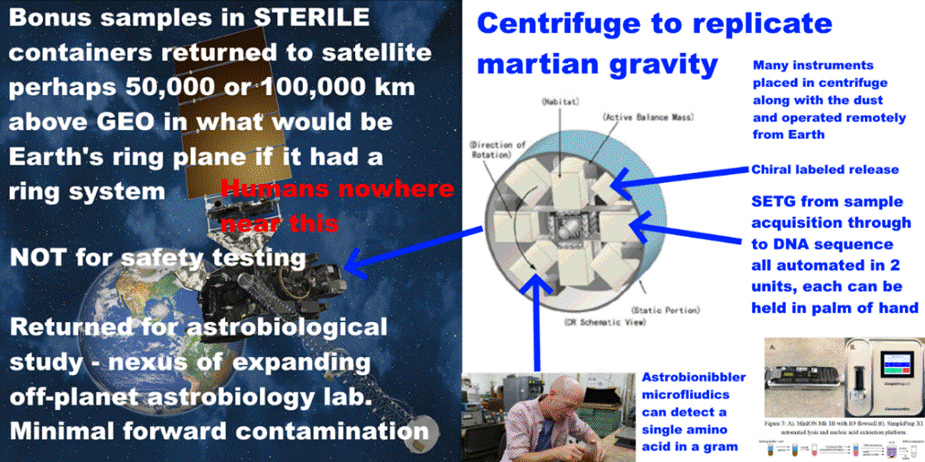
Text on graphic: Bonus samples in STERILE containers returned to satellite perhaps 50,000 or 100,000 km above GEO in what would be Earth’s ring plane if it had a ring system.
- NOT for safety testing
- Returned for astrobiological study – nexus of expanding off-planet astrobiology lab.
- Minimal forward contamination.
- Humans nowhere near this.
- Centrifuge to replicate martian gravity.
Many instruments placed in centrifuge along with the dust and operated remotely from Earth.
Graphic shows: (NOAA’s new GOES-17 weather satellite has degraded vision at night) just to have an image of a geostationary satellite, not that it would be a $2.5 billion dollar satellite. SETG from (Mojarro et al., 2016, SETG: nucleic acid extraction and sequencing for in situ life detection on Mars). Astrobionibbler from (Elleman, 2014, Path to Discovery) ISS centrifugal motor for plant experiments, dialable to any level from microgravity to 2g (Centrifuge Rotor [biology experiment on the ISS])
- Chiral labelled release.
- SETG from sample acquisition through to DNA sequence all automated in 2 units, each can be held in palm of hand.
- Astrobionibbler microfluidics can detect a single amino acid in a gram of sample
I'm sure a university would be delighted to design and build a Mars simulation chamber to fly to above GEO at its own expense, like the Michigan Mars simulation chamber. The cost to NASA would likely be minimal, mainly the cost of the shell of the satellite, solar panels and so on and launch costs. See:
There are numerous exquisitely sensitive life detection instruments now, that we can send there with the amazing shrinking of technology.You can endorse those here
No humans ever go anywhere near it and anything returned to the Earth's biosphere is thoroughly sterilized.
You can endorse this miniature lab alternative as well as the alternative to sterilize all samples or to defer returning samples until the risks are better understood and search in situ
You can endorse this reasonable alternative here:
You can also endorse the alterative to sterilize all samples
You can also endorse Chester Everline's alternative of a deferred sample return, prioritizing in situ searches on Mars.
NASA prescreened reasonable alternatives which is not permitted under NEPA and the EIS fails numerous NEPA requirements
They prescreened all alternatives suggested by the public with narrow requirements that can only be satisfied by a near clone of their own mission plan. This is not permitted under NEPA.
In a valid EIS, NASA should consider all reasonable alternatives so please feel free to endorse any or all of these that you consider to be reasonable, on the basis of your expertise.
NASA say several times that no outcome in science and engineering can be predicted with 100% certainty in response to people who ask for more rigorous planetary protection or suggest safer alternatives like sterilizing all samples returned to Earth. They use this response even to Chester Everline who suggests not returning the samples at all and to search in situ,.
No outcome in science and engineering processes can be predicted with 100% certainty.
(NASA, 2023, Mars Sample Return FINAL EIS : 4-8)
(NASA, 2023, Mars Sample Return FINAL EIS : B-38)
(NASA, 2023, Mars Sample Return FINAL EIS : B-55)
That of course is nonsense as if they don't return the samples at all there is no risk to Earth's biosphere or inhabitants. If they sterilize all samples returned to Earth with a sufficiently high level of sterilization there is no appreciable risk either.
NASA prescreened all three of the alternatives suggested by the public out of consideration because they had no way to prove the samples are safe.
For my example, though with the bonus samples in clean containers my solution could do a far better job of "safety testing" than they could do with their samples with so much terrestrial contamination at 8.1 ppb per gram, I argue there is no way for any sample return mission to do safety testing to a reasonable level of assurance at current level of understanding when there could be a single microbe from some distant location blown in the wind in the samples, especially since martian life might be pre-adapted with extra protection for transport in the dust and perhaps get to Jezero crater and still be viable in dust storms from as far away as the polar regions, such as Richardson crater.
If they looked more closely at the issue of terrestrial contamination, their prescreening criteria here would likely exclude their own mission plan!
The level of terrestrial contamination they permitted seemed acceptable according to the study they use which is from 2014, for a preliminary survey looking just at the levels of organics needed to detect the more abundant organics in Martian meteorites but don't take account of modern research into rapid degradation of organics in the presence of oxidants.
They prescreened all three alternatives out of consideration because they don't search for life in terrestrial laboratories.
They based that prescreening requirement on an out of date study from 2008.
NASA labelled my attachment describing the alternative in detail as "nonsubstantive" without reading it - so they never saw my long list of modern in situ instruments that we could send to such a laboratory - including several from NASA's own plan from 2016 to search for life in situ on Jupiter's moon Callisto.
They had such narrow prescreening that it was just about impossible for any alternative to get through the prescreening unless it was a near clone of their mission.
Prescreening like that is very much against NEPA requirements. They shouldn't do it.
Legally this EIS fails numerous requirements of NEPA. I think it's unlikely they consulted a NEPA lawyer, or if they did, they ignored what he or she suggested.
These are some of the issues I identify:
NASA can finalize their PEIS any time after June 26th (NEPA, 2023, NEPA; Mars Sample Return Campaign) I don't know if they have yet.
NASA prescreened all three of those reasonable alternatives out improperly because it has no way to prove the samples are safe (I argue there is no way for any sample return mission to do that at current level of understanding when there could be a single microbe from some distant location blown in the wind in the samples)
They also prescreened it out of consideration because it doesn't search for life in terrestrial laboratories. They based that on an out of date study from 2008, and because they labelled my attachment describing the alternative in detail as "nonsubstantive" without reading it - so they never saw my long list of modern in situ instruments that we could send to such a laboratory - including several from NASA's own plan from 2016 to search for life in situ on Jupiter's moon Callisto.
Prescreening like that is very much against NEPA requirements. They shouldn't do it.
But we do have a reasonable solution that plays to their strengths.
So I'm hoping to divert them away from their current path to consider my reasonable solution, which they are actually legally required to do.
Not as the only solution. But one they are legally required to look at, and hopefully would lead them to consider other solutions provided by others. But they are only legally required to listen to mine, and Chester Everline's solution to defer the sample return and the solution of several in the comments to sterilize all samples returned to Earth. So that's the situation.
I also have a longer term vision which I outlined in my attachments
- to prepare for a very rapid astrobiology survey of Mars in the 2030s from Earth then from orbit around Mars
- using heat sterilized 100% sterile landers, probes, eventually rovers
- which we now have the technology to do with modern high temperature electronics.
- with 100% planetary protection of both Earth and Mars until we can make our decisions
- based on knowledge rather than absence of knowledge
We now have the capability to specify components such as computer chips that actually function at 300°C. We have specifications for a complete Venus lander probe that can function for months at 500°C. Amino acids and bases break apart and vaporize at 300°C within minutes. Based on this it seems possible to achieve 100% sterile landers on Mars, a suggestion first made in 2018 by the Venus surface lander team. The Marscopter seems a good place to start as it is relatively simple in terms of technology and most, perhaps all of its components could perhaps be replaced by commercially available components that can function at 300°C. Especially with the objective to just survive heating to 300°C for a few minutes without damage, this seems within reach in the near future. The marscopter could heat itself up briefly with an internal heater after it separates from the rover or lander that brings it to Mars which would mean it could go up close to sensitive areas such as RSL's.
Then we could later do in situ cube sat sized probes dispersed over the surface of Mars to biologically interesting but sensitive areas - and then advance to 100% sterile complete rovers, cavebots, moles etc.
In this way we could do a rapid survey of Mars with no risk of forward contamination and far more complete than anything Carl Sagan could have envisioned.
So that's the proposal I made to NASA in my public comments. This would allow them to do the safety testing they want to do before sending humans to Mars.
We then achieve 100% planetary protection both ways. 100% protection of Mars and 100% protection of Earth using technology that didn't exist a decade or two ago.
With rapid development of 100% sterile landers on Mars to prepare for a rapid biological survey in the near future by specifying components that can withstand a few minutes of heating to 300°C before they reach Mars based on modern chips able to run at 300°C (silicon on insulator), other high temperature equipment such as video cameras and sensors placed near jet engines, and in electric cars, and NASA's own HOTTECH program to develop landers for Venus able to function for months even at 500°C
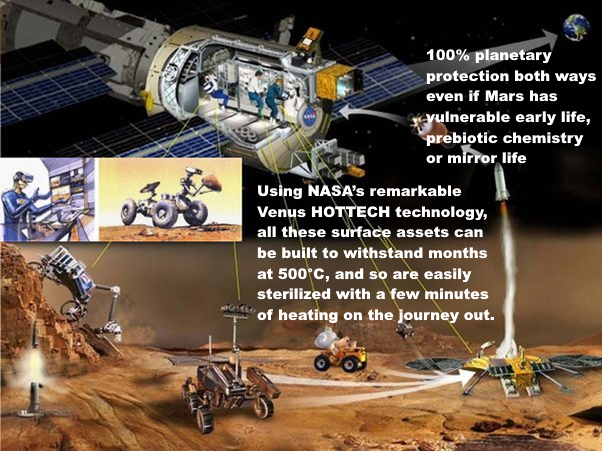
-
Main image: “Safely tucked inside orbiting habitat, space explorers use telepresence to operate machinery on Mars, even lobbing a sample of the Red Planet to the outpost for detailed study." (Telerobotics Could Help Humanity Explore Space) Tele-operated Centaur as an insert from: Carter Emmart / NASA Ames research center , Almost Being There: Why the Future of Space Exploration Is Not What You Think,
We can't assume that Mars is safe for humans as needed for NASA's end goal to land human astronauts on Mars and I feel it is important to make this clear to NASA.
Though this may be unlikely we have no way at present to know how easy or otherwise it is for independent life to evolve on Mars. If the probability is high we could have close to 50% probability of life evolved from mirror organics there, or even higher if the surface is not connected enough and life evolved independently several times, with the mirror life co-existing with ordinary life.
To help draw attention of space agencies to these issues I presented a vivid scenario to NASA of mirror life. However they don't respond to this in the public comments. There is no mention of the word "mirror" in the document. So they likely dismissed this as "nonsubstantive"
If you feel you can endorse any of this that would be a great help, or anything else on the page.
Important in all our communications to present it clearly as a low risk like a house fire
As I'm sure you'll know but sadly NASA doesn't, as is clear throughout this EIS, whenever talking about this we need to be especially careful not to present it in a scary way to vulnerable people. That's what I do with my time full time now that I'm retired, help vulnerable easily scared people with fact checking of the stories that scare them over the internet.
The way you present things is so important. I use Margaret Race's wonderful smoke detectors / house fire / fire extinguishers analogy (Rummel et al., 2000, Opinion: No Threat? No Way : 5) W from her reply to Zubrin's op ed. a lot - and it is really useful to explain what it's all about especially to anyone easily scared.
This is my graphic for it.

Hand installing smoke detector labeled “NASA” and wooden ceiling of a house labeled“Earth”
I am doing all this to get NASA to install a smoke detector but one that I think is exceptionally important despite the low risk, because Earth’s biosphere is a “house” with billions of people in it.
For more about how this is about a likely very low risk but a very low risk of high consequence for the worst case scenarios, like house fires and smoke detectors see:
Do feel free to share this letter with anyone else. If there is anyone else you can think of who would be good to contact to ask for endorsements do say.
Best,
Robert (Walker)
DRAFT: Open letter to NASA | Response to final PEIS | Fails NEPA requirements | Main points in open letter in more depth | Finding an inspiring future | Executive summary of preprint | Low risk like house fires and smoke detectors | About me | DRAFT: Endorsements by experts | Why this needs an open letter with endorsement | Call to NASA to defer or withdraw EIS | Letters | BOOK: Preprint to submit to academic publishers
Author: Robert Walker, contact email robert@robertinventor.com